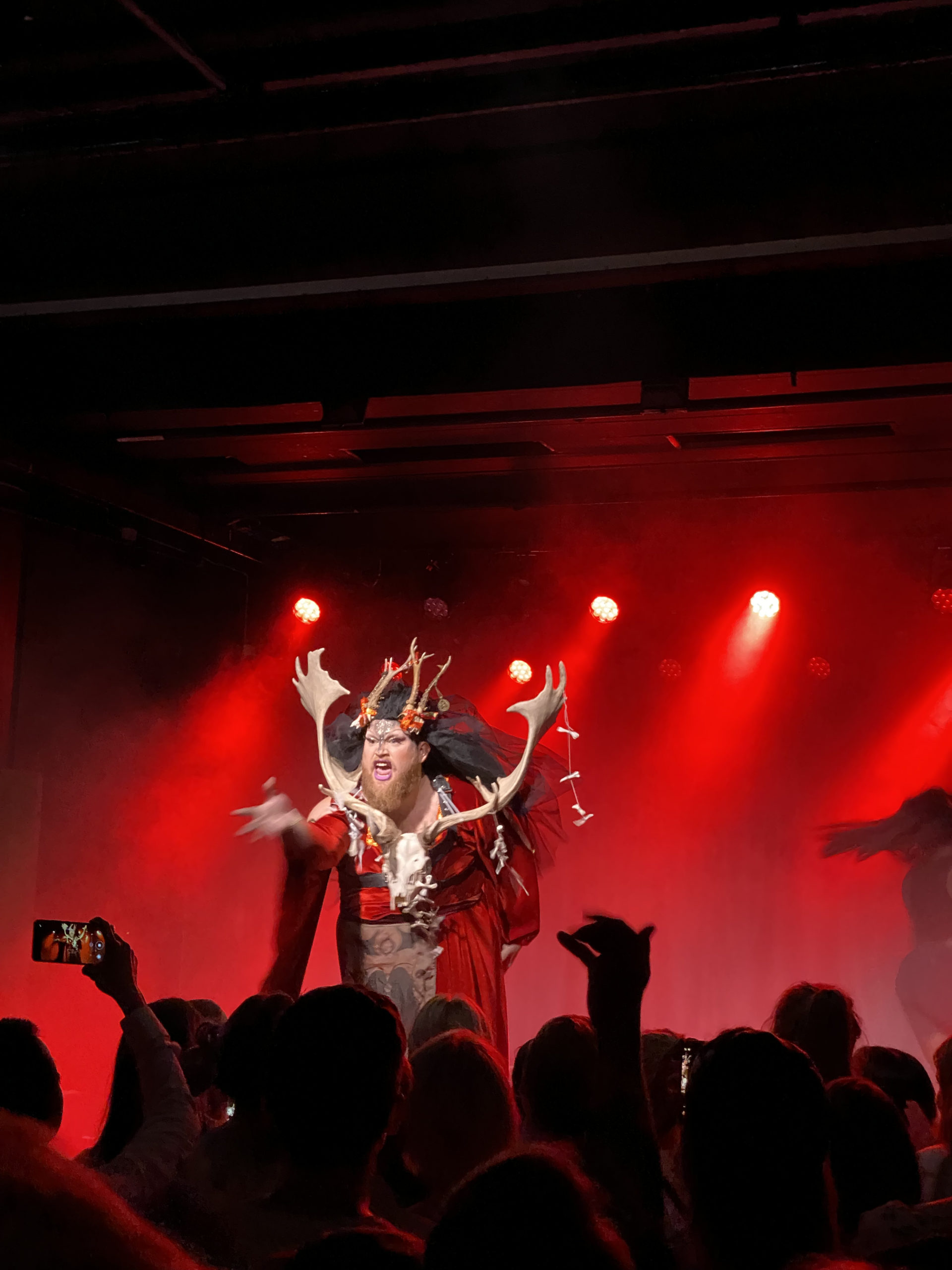
Gay Vikings and Femme Witches
By Bryn R. Frederiksmose
When it comes to issues that lie within the spectrum of identity and the markers that define our experience of life, I find it very important to be transparent about my own connection to the topic. Within this article, I will reflect on how the homogenization of whiteness has ridden us of culture, how the practices of my spirituality should be done through a critical analysis of where the practice comes from, and how Christianity has erased the practices of my ancestors. I will include historical contexts to parts of our Norse ancestry, which might not have been so queer-lacking as we have thought, but which should not be approached without a wariness of understanding historical sources through our modern view on queerness. I will not try to be objective, because true objectivity is a construct of oppression used to hold down marginalized individuals, and everything is always understood through the context of my own lived experiences. I’m a white trans-femme witch practitioner; often I just say I’m a völva, who recently began to delve into the practices of Seiðr, an old Norse form of spirituality. This article is to be understood from that position.
In the last few years we’ve seen more and more discourse on the topic of closed practices within the spiritual communities. A closed practice is a spiritual practice that is limited to those who are descendants of practitioners, and people who come from the culture the practice belongs to. This is often in the context of colonialism, racism, and reclaiming one’s lost identity. Many spiritual practices have been banned due to colonial regulations, and only recently have been allowed to practice. This has led to a loss of spirituality in a lot of racialized individuals, who are now working to reclaim what was taken from their ancestors. With this in mind, it does make sense to respect other people’s cultures, and not appropriate them to one’s own gain. This respect is needed, because even though some people believe that culture is meant to be shared, nothing is shared if a person claims something they don’t come from and twists the practice so that it fits into their own narrative. There is a word for taking something that doesn’t belong to one and claiming it as one’s own, and that’s colonization.
A lot of spiritual practices work with the help of ancestors, having them as guides to increase the effectiveness of one’s practice. It’s a way of honoring one’s own blood line, and, in this sense, it doesn’t make very much sense for a white person to practice indigenous spirituality, since the white ancestors were the ones to ban the practice in the first place. What are those ancestors going to do in the practice they themselves banned?
This raises a question that we need to talk more about: “How does the concept of whiteness strip white people of culture?” If we look into the creation of whiteness, and how it was used to divide and control people, it makes sense to question it. The construction of whiteness makes it so that our cultural heritage becomes homogenic, which is clearly visible in America, where culture is lacking and every white person somehow speaks from the same homogenized cultural reference and in desperation tries to find some kind of identity. We see plenty of people clinging to dreamcatchers, chakras, namaste, and voodoo, even though their bloodline was taking part in the destruction of those practices.
The creation of whiteness, and its historical function, can be read about more in depth in Jacqueline Battalora’s ‘Birth of a White Nation’. It is important to acknowledge and understand that we are all socialized into whiteness, and we must collectively liberate ourselves of the construction of whiteness, which is firstly done by understanding how it is built and how we unknowingly uphold white supremacy in our daily lives.
Before Christianity came to Scandinavia, there were widespread practices of the old Norse people, whose gods and practices aligned with the Norse culture. The practice of Seiðt (say-th) a kind of spirituality that involved rituals with chants and spirits to see into the future and find answers to the questions of the people. That was a practice often said to resemble the shamanic practices of the indigenous people of north Norway, also known as the Sami people. Seiðt is believed to also raise a question of queerness. Many scholars believe that the practice of Seiðt was only done by women, and the men who did practice, were seen as effeminate, which is believed to have had a taboo connected to it. Within Norse culture it is believed that there was a term called “ergi” (noun) or “argr” (adjective) which were used to insult a man’s manliness by denoting feminine behavior on him. The practice of spirituality, in this case often the practice of Seiðt, was considered an effeminate practice, so the male practitioners were considered ‘ergi’.
The practitioners of Seiðt were called Seiðkona and Seiðmaðr (Seidr woman and Seidr man) or vǫlva, which meant the staff carrier. Within Seiðr there were 4 pillars of practice, the 4 S’s: the song, the staff, the seat & the spirits. It was practiced by singing, or chanting songs in rhythms, while the practitioner held a staff to ground, upon a high seat, calling forth the spirits to find answers to the questions which they held.
Spiritual practices are queer, and queerness is spiritual. We can see it through our Scandinavian ancestors, who shamed men for practicing Seiðt, even though many of their gods were also believed to practice this effeminate sorcery. But not only was the practice of magic seen as queer and othering; the understanding of gender was also different from what we normally would believe. It is important to notice that we should be critical when it comes to how we interpret old Norse social beliefs, since we view them through the lens of our current social understanding. We should also be critical since many Norse studies from the 1900’s were done by Nazis to justify their goals of “purity”. The creation of the male and female binary is a colonial product, which was put into place so that the human experience could be coded into a strict system of man and the other gender (woman), with social characteristics to each gender. Many scholars argue that the Norse understanding of gender was different from the one we have now. Some would argue that the identities of Shieldmaidens and Valkyries were third genders in the context of being female-born masculine-behaved individuals. It is often criticized that it is an erasure of Viking lesbians, who might have been a little more masculine than other women and that it doesn’t necessarily mean that they were a third gender. Here we can again look to the practice of Seiðt, where men were seen as queer for practicing the spiritual arts. Could it not be argued that they also could be viewed as a third gender, the bridge from Male-born Femme-behaving?
A big part of spirituality is the personal growth that comes from it. We do not live in a vacuum where everything is without ties to our surroundings, and we have a responsibility, as citizens of the world, to limit the harm we might cause to other people. Certain structures are gigantic and incredibly hard to avoid taking part in. The simple act of grocery shopping adds great amounts of “bad points” to our afterlife-score-chart, simply because of the way consumption is done in the West — at the expense of (what we call) the Global South. But what we can do, on the personal level, is to learn and understand how we unknowingly reproduce the structure which oppresses and upholds the generational entitlement, that anything and everything is for our consumption, without respect. Decolonizing your spiritual practice is a must in today’s day and age and needs to be done with humility and respect. Often it can be done through discovering your own heritage, because, as we know, whiteness works to homogenize, and part of the inner work you can do is to discover where your roots go, and how that practice was done before Christianity corrupted the minds of your ancestors with the promises of power and wealth.
“Decolonizing your spiritual practice is a must in today’s day and age and needs to be done with humility and respect.”
To me, slowly discovering and unearthing parts of the history that connects to me is a process of understanding my place in the world, but also finding a way home. For many years, it has felt like sailing upon the open seas, with the high waves trashing my boat, letting the gale control my path. But the moment I learned of the bearded effeminate völva, it was like the stars began to guide my way to shore.
I appreciate other practices of spirituality a lot, but I also understand that my place should only be as a distanced appreciator and not as someone taking part in the practice. A big part of the appreciation is also learning how gender and society functioned in the context of spirituality. Even if I am not connected by blood, learning how transness has existed for many thousand years, especially in the context of spirituality, brings bliss and belonging. And even though I probably only understand the complexity of gender through our current time aged lens, I have a great deal of honor and respect for the ‘trancestors’ (wordplay on ancestor and trans) who came before me. All the way back to the clay engravings of the tale of Ninhursag, who created a being without male or female organs, and how the god Enki placed this being of no gender next to the king within society; the third gendered worshippers of Ishtar, who were described as people with both female and male characteristics within the Sumer society; the Greek’s androgynous people, who in Platon’s Symposium were described as powerful double-beings that Zeus had to half, because they became too prideful; and the Qquari-warmi’ of the Inkan society, who were shamans that connected the duality of the world by being both a man and woman.
Colonialism has attempted to rid the world of identity and homogenize us to a uniform being of no-identity, where deviations, such as queerness, is seen as a threat. So, to liberate ourselves, our spiritual practice should be ancient, honoring the roots of our pre-Christian beliefs and from there connecting us, once again, to the world around us. But this raises a final question: isn’t then the queerness of spirituality, and queerness in general, also a product of our colonial history? After all, what we consider queer existed way before Columbus committed genocide, and the only existence of queerness is a testimony to what is othered from the oppressive structure of our society.



